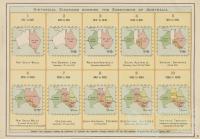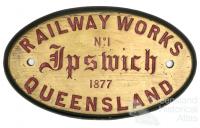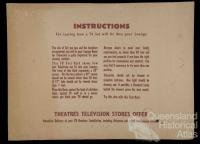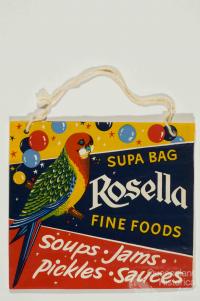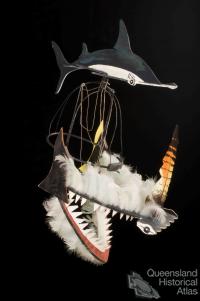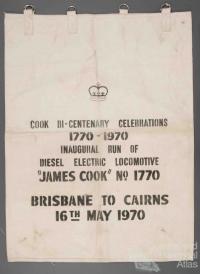- Home
- Quintessential Queensland
- Distinctiveness
- Perceptions
- Perceptions: how people understand the landscape
- From runs to closer settlement
- Geological survey of Queensland
- Mapping a new colony, 1860-80
- Mapping the Torres Strait: from TI to Magani Malu and Zenadh Kes
- Order in Paradise: a colonial gold field
- Queensland atlas, 1865
- Queensland mapping since 1900
- Queensland: the slogan state
- Rainforests of North Queensland
- Walkabout
- Queenslanders
- Queenslanders: people in the landscape
- Aboriginal heroes: episodes in the colonial landscape
- Australian South Sea Islanders
- Cane fields and solidarity in the multiethnic north
- Chinatowns
- Colonial immigration to Queensland
- Greek Cafés in the landscape of Queensland
- Hispanics and human rights in Queensland’s public spaces
- Italians in north Queensland
- Lebanese in rural Queensland
- Queensland clothing
- Queensland for ‘the best kind of population, primary producers’
- Too remote, too primitive and too expensive: Scandinavian settlers in colonial Queensland
- Distance
- Movement
- Movement: how people move through the landscape
- Air travel in Queensland
- Bicycling through Brisbane, 1896
- Cobb & Co
- Journey to Hayman Island, 1938
- Law and story-strings
- Mobile kids: children’s explorations of Cherbourg
- Movable heritage of North Queensland
- Passages to India: military linkages with Queensland
- The Queen in Queensland, 1954
- Transient Chinese in colonial Queensland
- Travelling times by rail
- Pathways
- Pathways: how things move through the landscape and where they are made
- Aboriginal dreaming paths and trading ways
- Chinese traders in the nineteenth century
- Introducing the cane toad
- Pituri bag
- Press and the media
- Radio in Queensland
- Red Cross Society and World War I in Queensland
- The telephone in Queensland
- Where did the trams go?
- ‘A little bit of love for me and a murder for my old man’: the Queensland Bush Book Club
- Movement
- Division
- Separation
- Separation: divisions in the landscape
- Asylums in the landscape
- Brisbane River
- Changing landscape of radicalism
- Civil government boundaries
- Convict Brisbane
- Dividing Queensland - Pauline Hanson’s One Nation Party
- High water mark: the shifting electoral landscape 2001-12
- Hospitals in the landscape
- Indigenous health
- Palm Island
- Secession movements
- Separate spheres: gender and dress codes
- Separating land, separating culture
- Stone walls do a prison make: law on the landscape
- The 1967 Referendum – the State comes together?
- Utopian communities
- Whiteness in the tropics
- Conflict
- Conflict: how people contest the landscape
- A tale of two elections – One Nation and political protest
- Battle of Brisbane – Australian masculinity under threat
- Dangerous spaces - youth politics in Brisbane, 1960s-70s
- Fortress Queensland 1942-45
- Grassy hills: colonial defence and coastal forts
- Great Shearers’ Strike of 1891
- Iwasaki project
- Johannes Bjelke-Petersen: straddling a barbed wire fence
- Mount Etna: Queensland's longest environmental conflict
- Native Police
- Skyrail Cairns (Research notes)
- Staunch but conservative – the trade union movement in Rockhampton
- The Chinese question
- Thomas Wentworth Wills and Cullin-la-ringo Station
- Separation
- Dreaming
- Imagination
- Imagination: how people have imagined Queensland
- Brisbane River and Moreton Bay: Thomas Welsby
- Changing views of the Glasshouse Mountains
- Imagining Queensland in film and television production
- Jacaranda
- Literary mapping of Brisbane in the 1990s
- Looking at Mount Coot-tha
- Mapping the Macqueen farm
- Mapping the mythic: Hugh Sawrey's ‘outback’
- People’s Republic of Woodford
- Poinsettia city: Brisbane’s flower
- The Pineapple Girl
- The writers of Tamborine Mountain
- Vance and Nettie Palmer
- Memory
- Memory: how people remember the landscape
- Anna Wickham: the memory of a moment
- Berajondo and Mill Point: remembering place and landscape
- Cemeteries in the landscape
- Landscapes of memory: Tjapukai Dance Theatre and Laura Festival
- Monuments and memory: T.J. Byrnes and T.J. Ryan
- Out where the dead towns lie
- Queensland in miniature: the Brisbane Exhibition
- Roadside ++++ memorials
- Shipwrecks as graves
- The Dame in the tropics: Nellie Melba
- Tinnenburra
- Vanished heritage
- War memorials
- Curiosity
- Curiosity: knowledge through the landscape
- A playground for science: Great Barrier Reef
- Duboisia hopwoodii: a colonial curiosity
- Great Artesian Basin: water from deeper down
- In search of Landsborough
- James Cook’s hundred days in Queensland
- Mutual curiosity – Aboriginal people and explorers
- Queensland Acclimatisation Society
- Queensland’s own sea monster: a curious tale of loss and regret
- St Lucia: degrees of landscape
- Townsville’s Mount St John Zoo
- Imagination
- Development
- Exploitation
- Transformation
- Transformation: how the landscape has changed and been modified
- Cultivation
- Empire and agribusiness: the Australian Mercantile Land and Finance Company
- Gold
- Kill, cure, or strangle: Atherton Tablelands
- National parks in Queensland
- Pastoralism 1860s–1915
- Prickly pear
- Repurchasing estates: the transformation of Durundur
- Soil
- Sugar
- Sunshine Coast
- The Brigalow
- Walter Reid Cultural Centre, Rockhampton: back again
- Survival
- Survival: how the landscape impacts on people
- Brisbane floods: 1893 to the summer of sorrow
- City of the Damned: how the media embraced the Brisbane floods
- Depression era
- Did Clem Jones save Brisbane from flood?
- Droughts and floods and rail
- Missions and reserves
- Queensland British Food Corporation
- Rockhampton’s great flood of 1918
- Station homesteads
- Tropical cyclones
- Wreck of the Quetta
- Pleasure
- Pleasure: how people enjoy the landscape
- Bushwalking in Queensland
- Cherbourg that’s my home: celebrating landscape through song
- Creating rural attractions
- Festivals
- Queer pleasure: masculinity, male homosexuality and public space
- Railway refreshment rooms
- Regional cinema
- Schoolies week: a festival of misrule
- The sporting landscape
- Visiting the Great Barrier Reef
By:
Geraldine Mate The markers of how we remember in the landscape seem to be everywhere. The reminders of the 1974 flood, or even the 1893 flood, sneak up and are found in unexpected places like the rafters of a picnic shelter. Park names proclaim the stories of prominent or well regarded members of local communities. The markers of loss – a cross and a posy of flowers marking the place of yet another fatal car accident involving a young person – appear at otherwise unremarkable points along the highway. Why do we mark these spots in this way? It is perhaps a reminder, a warning to others to drive more carefully, take it slower around the corners; to be wary of floods. But these markers are also focal points for remembering - whether of people or events, big or small.
Memorials
A particular form of remembrance – that of soldiers fallen in another time, another land – is marked by cenotaphs and memorials in towns, cities and even in the middle of nowhere. The Brooweena War Memorial Bridge, on the road from Woolooga to Biggenden, was constructed in 1921 to honour the nine local men who fell in World War I. This prominent feature in the landscape is remarkable. Not only is it an unusual form of memorial, but by virtue of its isolation, its solitary station in the landscape, it is most effective in meeting its intent. One cannot drive past it without thinking of the loss, the community purpose, the ‘diggers’ inspiring the commemoration.
Not so the cenotaphs of suburban streets that, for the most part, we move quickly and unthinkingly past. In the centre of Bundaberg, we can drive past the war memorial heading along Bourbong Street and never really glance up – in an everyday journey, it is a mark in the landscape that indicates an intersection, not a remembrance of the fallen. Yet when the same monument is passed on foot, or visited for an Anzac Day service, we ponder the supreme sacrifice; we find ourselves imagining the place where soldiers fell, the grief of their family, the location of their graves. It’s the same along the footpath at Shelley Beach near Caloundra. Those familiar stride past every day on their power walk. But visitors stroll along in a more leisurely fashion, looking at the memorial plaques embedded in the path, reading names of the fallen and wondering why this place was important to these servicemen and women or their families. They might also stop at the nearby memorial for the Centaur and think of the hospital ship sinking out past Moreton Island in 1943, over 250 men and women losing their lives. These markers are one way we remember in the landscape. Yet, unlike the posy of flowers or the flood markers, these points of remembrance are not at the location of the event, instead they are a marked place in our landscape for remembering, one place that represent perhaps a myriad of places near and distant, with stories of loss and sacrifice. Many of the memorials were erected at a time when national and patriotic fervour were high, following the extensive loss of life in World War I and contributed in some ways to our sense of identity as Australians. Others are more recent acknowledgements of the cost of war. But they all provided a prominent focal point for remembrances of those lost in combat.
Back to Cloudland
There are other places where we remember what was there before. The set of apartments on the hilltop at Bowen Hills marks not another successful development but a former entertainment venue, the place where thousands of young Brisbane men and women attended debutant balls, dances, and concerts. It was a place where romances were started and proposals made. The ABC Radio event ‘Back to Cloudland’, held in 2008 more than 25 years after the demolition of the old ballroom with the sprung dance floor, showed the true depth of feelings still associated with the site. ABC listeners vied for the opportunity to attend the event by recounting their memories of Cloudland, with stories of the dresses worn and correct behaviour and of many long marriages beginning with a meeting there. So places we remember can have disappeared and yet still mean something to us.
Vanished landscapes
There are other places that have little or no outward sign of what once was, but are still identified and remembered for events or purposes long gone: the site of the cemetery at Mill Point, in use for only 20 years in the second half of the nineteenth century is marked and often visited despite the gravestones being removed long ago; The Cobb and Co coach stop at Blackdown Tablelands, once a busy hub, is now only visible as a scatter of artefacts; and the deeply felt memories associated with massacre sites are marked only by peoples’ stories. These ephemeral places are no less real and remembered for their transience. This idea, that a place with no outward marking can mean something, shows how meaning can be created through events or activities that are associated with a place, rather than any particular structure. The structure may mark the place but is not necessary for the meaning.
Understanding landscapes
So landscapes can be meaningfully encountered – that is, people understand, interact and remember landscapes, and see them as having meaning. Landscapes are also socially constructed – how we understand and interact with landscape is influenced by our own socialisation and situation. And as we move through, journey across, use, remember and take meaning from landscapes, we engage with them – they are engaged spaces, held fast, interlocked in our minds and we take part in these landscapes. Therefore, our world-view – how we understand our landscape and our part in it, impacted by our personal experience – has a profound influence on how and what we remember and take from our landscape and how we glean meaning from newly encountered places.
Part of who we are is linked to things we have done, stories we have heard or told, and to people and events we have encountered in our landscapes. In this way, landscapes can be understood to be multilayered, holding different sets of memories and stories for different groups. We might see a particular landscape not as it first appears to an unengaged observer but within the context of our own experience. For some this means a spot in the landscape is symbolic of grief and loss whilst to others it might appear unremarkable. In the same way, Indigenous and non-Indigenous Australians may see a landscape differently, to the first an important or sacred place, to others an insignificant paddock or rock formation. So collective ideas, shared by groups, can socially construct a landscape and there can be collective remembering of places and events. But landscapes can equally be individual and personal.
Personal landscapes
Individually our memories are full of remembered places and the things that happened there, the people we were with, and the really big events. The landscapes of our youth are made up of these often visited / once visited places – where you rode your bike / where you came off and skinned your knee; the inside of your grandmothers’ house visited every weekend / going to the Cairns show or the Ekka once a year; the local swimming pool / the beach house rented on the coast one holiday – and these are well remembered landscapes. Everyone has a story – of a trip to the show, a favourite pavilion, a remembered holiday, a special place – that is part of our own identity.
Sense-scapes
Sense-scapes are a part of how we remember in a landscape, a particular smell, or vista transporting us instantly back to a place in time. We remember the ‘feel’ of the beach not just the geography: the heat of the sun, how the hot sand crunches in our toes, the bitumen burning the soles of feet as we run across to the shop, and the stickiness of melted ice cream; the smell of the sunscreen; the sound of the waves as we lie in bed at night. The remembering continues when we get home – the sand that somehow made it back inside shoes and the catch of sunburn bringing back the beach – a place encountered and recalled.
Souvenirs and stories
Many of us use souvenirs to recount stories of feelings and places. We remember landscapes and visits through the postcards, photos, tea-towels and ornaments depicting a place. And through museums we revisit and re-create in our minds past places, landscapes and stories. Stories are important for remembering landscapes and journeys to places and across landscapes, where stories are told and retold, serve to reinforce our memory of people and events, remembering in landscapes. Dramatic natural features of landscape often fix our remembering in place, embedding memory in trees, rivers, rocky outcrops or distinctive mountains. For instance, the childhood story of dropping a stone and counting at the Crater Lake brings forth a specific landscape of strangler figs, leeches, cicadas and the hot hike up to the crater – these landscapes and sense-scapes form part of the construction of memories.
Rock art
But there are deeper meanings and memories for place and landscape than those of travel or childhood. For some, many, there can be a deeper more profound attachment to a place as sacred or highly significant. Indigenous remembering and knowledge is inherently linked to the landscape through story lines. These can be performative markings of place, in place, through song and story, but can also be visually recounted through rock art. The modification and creation of landscape is in itself an act of remembering.
Engraving, painting, regular renewal and revisiting rock art are all forms of modification of the land and, for Aboriginal people, constitute the act of marking place and remembering. And like other aspects of storyline, there is performance of rock art in visiting and renewal. This continues today and for traditional owners, according to Howard Morphy, ‘paintings are equally part of the present and the past’, different times and layers still having currency. Beyond this, performance can be a way of making things belong – remembering, curating and recounting stories constituting assertions of ownership in one form or another. More than ownership, however, the act of visiting and marking places with rock art is spiritual maintenance, maintaining connections and keeping stories and ancestors in consciousness. In some instances representation in rock art are associated with making a landscape – an acknowledgment of the beings that created the landscape. And rock art can be placed at the edges of country, a way of remembering, marking place that is encountered differently by different people. In this way, rock art can show how subjective ways of knowing are. Different levels of knowledge associated with places reflect Indigenous approaches to sacred knowledge, layers of meaning and knowledge, with places remembered differently by different people.
Journeys
In all of these examples, the journeys taken across the landscape are what makes and yields the memories, the connection to stories, people and elsewhere. Remembrance of all kinds can be evocative, imagined and even romanticised. In Luke Keogh’s (2008) essay about coal mines and homesteads he reflects on how if we look hard enough we can find the memories of places occupied long ago. He shows how the act of visiting, the journey across the country, is an important part of remembering. People have long visited the remnants and viewed the historic landscapes of Queensland with nostalgia, remembering the successes and excesses of the Palmer River gold rush, reflecting on the hard life of the graziers in the west or celebrating the natural settings of the rainforest. And the projections of the past have stayed with us in our understanding of the place we live. The same view of Queensland has been promoted through the State’s history with early presentations at exhibitions and celebrations of its jubilee and centenary emphasising the pastoral idyll and the resource rich land represented by landscapes of mining and pastoralism, and the carving out of living by clearing and settling. Landscapes are represented as such in works by Daintree and in the booklets, writings and exhibitions mounted to ‘celebrate’ the founding of Queensland.
The way Queensland was remembered at its sesquicentenary, was equally influenced by these connections to the landscape, but was carried out within a context greatly changed from 1959. We live in a more global world, a world where security is ever more present and movement, while much faster, seems far less free; but also a world where the nation has said sorry to the Stolen Generation, where there is recognition of Native Title and Land Rights, and where we acknowledge different ways of knowing, recognising the long and ancient Aboriginal past before European occupation and the multicultural society Queensland is becoming. Perhaps the lens of time used at the bicentenary of Queensland will in turn show our own biased accounts of history and failure to acknowledge some aspect of our past identified as important over the next 50 years. Whatever the case for the future, our understanding of social, cultural and historic context is today a vital part of understanding and remembrance of and in a landscape.
If, as Van Dyke suggests, place lies at the intersection of memory and landscape then this intersection is manifested in stories, journeys, transformations, modification and inscription across the landscape. Just as rock art is a marking of place, a recording of stories, a mnemonic for cultural and sacred knowledge, so too are cemeteries and memorials of war. However, not all memories are marked in the landscape. Instead the stories themselves and the act of telling the story or visiting the place are the acts of remembering in the landscape. There is no doubt memory is closely bound to place and our memories would not stand alone without a landscape to remember in.
References and Further reading (Note):
Luke Keogh ‘Returning to Eden’ Crossroads 3/1, 2008
References and Further reading (Note):
Howard Morphy, Aboriginal art, Phaidon Press, London, 1998
References and Further reading (Note):
Paul Tacon, ‘Identifying sacred landscapes in Australia: from physical to social’, in W. Ashmore and A.B. Knapp (eds) Archaeologies of landscape: contemporary perspectives. Blackwell, Oxford, 1999
References and Further reading (Note):
Ruth Van Dyke & Susan Alcock (eds), Archaeologies of memory, Blackwell, Malden, 2003

